Pressure washing might seem like a miracle solution to clean those stubborn stains or grimy surfaces, but it’s not all sunshine and rainbows. One of the biggest cons? The risk of damaging the very surfaces you’re trying to clean. Too much power can strip paint, etch concrete, or gouge wood. Not the makeover you were hoping for, right?
But wait, there's more. Pressure washing isn't the greenest cleaning method out there. It can wash away not only dirt but also pollutants into your garden or local waterways, which isn’t great for the environment. So much for being eco-friendly.
Risk of Surface Damage
When it comes to pressure washing, it's crucial to remember that not all surfaces are created equal. While some materials can handle the strong jets of water, others might not be so lucky. One of the primary concerns is the damage it can potentially cause.
Common Surfaces at Risk
Wooden decks and fences are classic victims. If you go overboard with pressure or linger too long in one spot, you can strip off layers, leaving an uneven surface. The same goes for delicate brickwork or aged concrete; use lower pressure and maintain a steady hand to avoid chipping or erosion.
What Causes Damage?
- High Pressure: Using excessively high pressure settings can gouge wood, strip paint, and even carve unsightly lines or patterns into sensitive surfaces.
- Incorrect Nozzle: Using the wrong nozzle for the task can focus the pressure too tightly on one spot, concentrating damage rather than spreading it out safely.
- Improper Technique: Not keeping a steady hand or angle can lead to inconsistent results, with some areas being blasted too aggressively.
Tips to Avoid Damage
- Test First: Always start with a low pressure setting on a small, inconspicuous area to see how the surface responds.
- Select the Right Nozzle: Choose a nozzle appropriate for the material and level of cleaning needed. Fan nozzles spread pressure out, reducing the risk of harm.
- Maintain Distance: Keep a consistent distance from the surface to avoid hitting it with too much force.
Environmental Concerns
Getting your driveway spotless might seem like a good idea, but you could be hurting the environment without even knowing it. When you use pressure washing, you're not just blasting away dirt; you're also sending chemicals, oils, and other pollutants into the ground or storm drains, which leads right to local waterways.
So, what exactly happens? The water runoff from pressure washers can carry harmful substances from certain cleaning agents, which damage aquatic life and contaminate drinking water sources. Especially when using detergents with potentially dangerous chemicals, it gets dicey. This effect gets magnified if you live near rivers, lakes, or the ocean. So, if being eco-friendly matters to you, that’s one big con to think about.
What Can You Do?
Thankfully, there are ways to minimize your environmental footprint when pressure washing. Here are a few tips:
- Choose Biodegradable Detergents: Opt for cleaners that are eco-friendly and break down faster, minimizing environmental harm.
- Practice Smart Disposal: Direct runoff to permeable surfaces like grass, where it can be naturally filtered.
- Use Low Pressure: Adjust your washer to a lower setting to reduce excessive water and chemical runoff.
By being conscious of these practices, you don’t just keep your property clean—you're also doing a favor for Mother Nature. Remember, it's not just about the clean look; it's about making pressure washing as sustainable as possible.

Safety Hazards
Let's be honest, handling a pressure washer isn't exactly a walk in the park. These machines can be tricky and even downright dangerous if you're not careful. Did you know that some models can spray water at 3,000 psi or more? That's strong enough to cause serious injury.
Personal Injury Risks
The most direct risk comes from flying debris or accidental contact with the high-pressure stream. The intense water jet can cut through skin and tissue, leading to nasty injuries that really aren’t fun to deal with.
Electrical Dangers
Water and electricity are a dangerous combo. When pressure washing, it’s crucial to avoid electrical outlets and wiring to prevent electric shock. Double-checking you’re using a machine with proper insulation is way more important than you think.
Slips and Falls
A wet surface is a slippery one. When working on ladders or around various outdoor settings, the risk of falling increases. It’s vital to wear non-slip shoes and be mindful of your surroundings to keep yourself upright and injury-free.
Equipment Safety Tips
- Always read your machine’s manual before use. Knowing how to operate it correctly saves you a world of trouble.
- Use protective gear like goggles and gloves to shield yourself from flying debris and accidental sprays.
- Keep a safe distance between the pressure washer and the surface you’re cleaning. Standing too close increases injury risk.
- Be cautious when using ladders; it’s easy to overbalance when the force of water hits unexpectedly.
By staying aware of these safety risks, and prepping properly, you can significantly reduce the potential hazards of using a pressure washer. Make sure you - and anyone around - is keeping safe while getting the job done.
Equipment and Cost Issues
Let’s talk about the often-overlooked downside of the pressure washing game: the gear and the dough involved. First off, getting your hands on a decent pressure washer isn't always light on the wallet. A good quality machine can set you back anywhere between $300 to $1,000, depending on whether you want electric or gas-powered, each with its own advantages and pitfalls.
And it's not just about buying the machine. There's a whole spectrum of accessories you might need, from nozzles and hoses to detergents tailored for specific surfaces. These extras can quickly add to your costs. If you're thinking of renting instead of buying, sure, it's an option, but you're still looking at around $40 to $100 per day. And don’t forget about any last-minute trips to grab cleaning solutions!
Don’t just focus on the sticker price either. Maintenance is key with pressure washing equipment. Keeping everything in top-notch shape means routine upkeep, and if you're not the DIY type, professional servicing will cost you. Keeping up with regular check-ups and replacing worn-out parts is crucial for longevity but can pile on costs unexpectedly.
Plus, if you're handing off the cleanup duty to a pro, remember that service fees can vary wildly based on your location and the size of your project. In some areas, you might fork over $0.30 to $0.80 per square foot for professional cleaning services.
Saving money sounds great on paper, but when you account for potential mistakes from improper use—like damaging your house siding or windows—it could cost more in damages than doing it right the first time. So, weigh these factors and keep a tight rein on your tool budget when you're pressure washing your to-do list.
